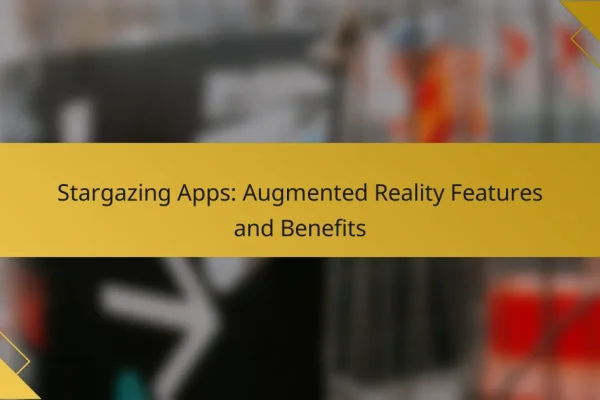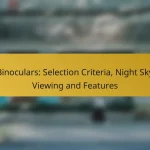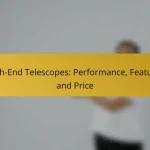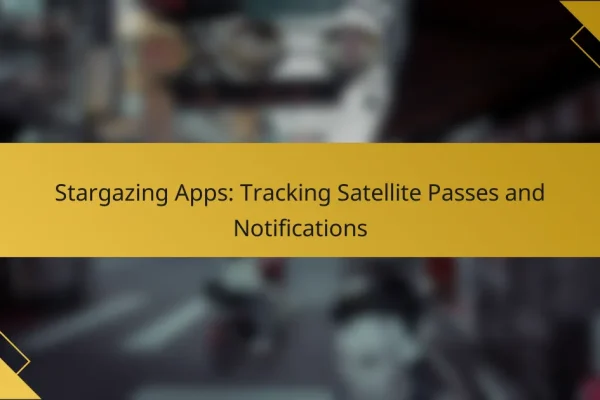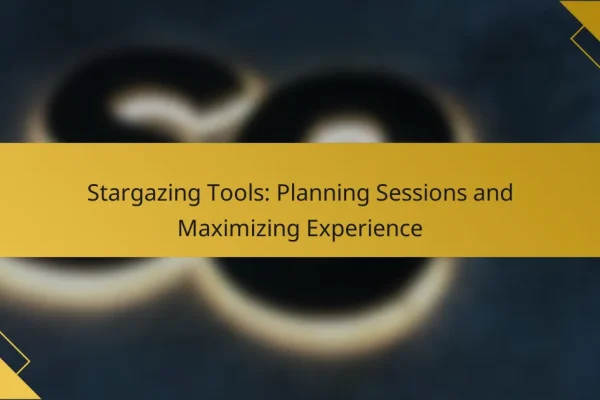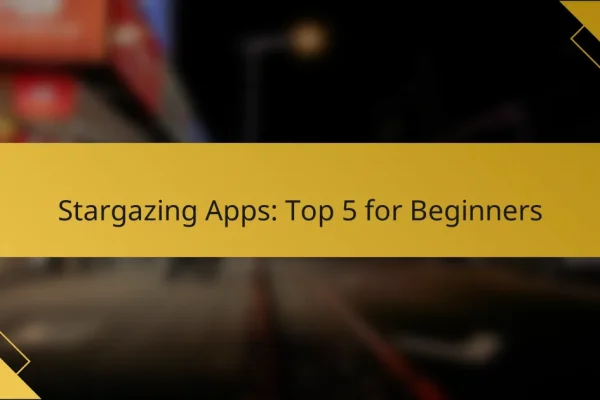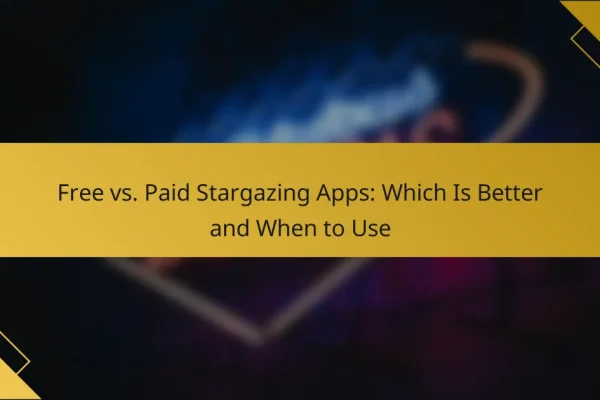What are the best stargazing apps for beginners?
The best stargazing apps for beginners are user-friendly and provide clear guidance on identifying celestial objects. They typically feature interactive star maps, augmented reality, and educational content to enhance the stargazing experience.
SkyView
SkyView is an intuitive app that allows users to point their device at the sky to identify stars, constellations, and satellites. It utilizes augmented reality to overlay information on the night sky, making it easy for beginners to learn about celestial bodies.
This app is available for both iOS and Android devices, and it offers a simple interface that requires minimal setup. Users can explore different modes, including a night mode that reduces screen brightness for better visibility in dark environments.
Star Walk 2
Star Walk 2 is designed for both novices and experienced stargazers, offering a rich visual experience with real-time data. The app features a comprehensive database of stars, planets, and constellations, along with detailed descriptions and images.
One of its standout features is the time travel function, allowing users to view the night sky as it appeared in the past or will appear in the future. This can deepen understanding of celestial movements and events, making it a valuable tool for learning.
Stellarium
Stellarium is a powerful planetarium app that provides a realistic 3D simulation of the night sky. It is particularly useful for those who want a detailed view of celestial events and the ability to customize their stargazing experience.
Available on multiple platforms, including desktop and mobile, Stellarium offers extensive features such as the ability to track satellites and view the sky from different locations. Beginners may appreciate its educational tools, which include guided tours and information on astronomical events.
How do stargazing tools enhance the experience?
Stargazing tools significantly enhance the experience by providing users with accurate information about celestial objects and their movements. These tools help both beginners and seasoned astronomers identify stars, planets, and constellations in real-time, making the night sky more accessible and engaging.
Real-time tracking of celestial objects
Real-time tracking allows users to follow the movement of celestial objects as they appear in the night sky. Many stargazing apps use GPS and compass features to align with the user’s location, providing a dynamic view of stars and planets based on the current time and position.
For effective tracking, ensure your device’s location services are enabled. Some popular apps can even send notifications when specific celestial events, like meteor showers or planetary alignments, are about to occur, enhancing your stargazing experience.
Augmented reality features
Augmented reality (AR) features in stargazing apps overlay digital information onto the real-world view of the night sky. By pointing your smartphone or tablet at a section of the sky, you can see names and details of stars, constellations, and other celestial bodies superimposed on the display.
When using AR features, consider the lighting conditions; a dark environment will yield the best results. Some apps allow users to customize the information displayed, such as filtering by brightness or distance, which can help focus on specific objects of interest.
What are the top features to look for in stargazing apps?
When choosing a stargazing app, prioritize features like interactive star maps, offline functionality, and community sharing options. These elements enhance the user experience by providing detailed celestial visuals, accessibility in remote areas, and opportunities for social engagement with fellow astronomy enthusiasts.
Interactive star maps
Interactive star maps are essential for stargazing apps as they allow users to visualize constellations, planets, and other celestial objects in real-time. Look for apps that offer augmented reality (AR) features, enabling you to point your device at the sky and see the names and details of stars and planets. Some popular apps even allow users to customize their maps based on their location and time settings.
Consider apps that provide detailed information about celestial events, such as meteor showers or eclipses, directly on the star map. This feature helps users plan their stargazing sessions around significant astronomical occurrences.
Offline functionality
Offline functionality is crucial for stargazing, especially if you plan to explore remote areas with limited internet access. Choose apps that allow you to download star maps and essential data for offline use, ensuring you can still identify celestial objects without a data connection. This feature is particularly useful for camping trips or visits to national parks.
Check if the app offers a way to save your favorite locations or observations for offline access. This can enhance your stargazing experience by allowing you to revisit specific spots or track your observations over time.
Community sharing options
Community sharing options in stargazing apps foster interaction among users, allowing you to share your observations, photos, and experiences with fellow astronomy enthusiasts. Look for apps that include social features, such as forums or social media integration, where you can discuss findings or ask questions.
Some apps may offer challenges or events that encourage users to participate and share their stargazing experiences. Engaging with a community can enhance your learning and appreciation of astronomy, providing motivation to explore more of the night sky.
Which stargazing tools are best for astrophotography?
For astrophotography, the best stargazing tools are those that provide detailed star maps, tracking capabilities, and planning features. These tools help photographers identify celestial objects, optimize shooting conditions, and enhance image quality.
SkySafari
SkySafari is a powerful stargazing app that offers extensive databases of stars, planets, and deep-sky objects. It features a user-friendly interface that allows users to track celestial events and plan astrophotography sessions effectively.
One of its key advantages is the ability to simulate the night sky from any location and time, making it easier to find optimal shooting conditions. SkySafari also includes telescope control features, which can enhance the astrophotography experience.
PhotoPills
PhotoPills is an essential tool for photographers, combining stargazing with planning features tailored for astrophotography. It allows users to calculate the best times for shooting the Milky Way, lunar events, and other celestial phenomena.
This app provides a range of features, including a planner for tracking the moon’s position, a depth of field calculator, and a 3D augmented reality view of the night sky. These tools help photographers make informed decisions about their shots, ensuring they capture stunning images.
What are the pricing options for popular stargazing apps?
Stargazing apps typically offer a variety of pricing options, including free versions, premium one-time purchases, and subscription models. The choice depends on the features you need and how often you plan to use the app.
Free vs. premium versions
Many stargazing apps provide free versions with basic features, such as star maps and constellation identification. However, premium versions often unlock advanced functionalities like augmented reality views, detailed astronomical data, and ad-free experiences.
For example, apps like SkyView and Star Walk offer free access to fundamental features but charge around $2 to $5 for their premium versions, which enhance the user experience significantly. Consider your stargazing habits to determine if the premium features justify the cost.
Subscription models
Some stargazing apps operate on a subscription basis, typically charging monthly or annually. This model often provides continuous updates, access to new features, and premium content, appealing to avid stargazers.
Subscriptions can range from about $1 to $10 per month, depending on the app and the features included. For instance, apps like SkySafari offer a subscription that includes extensive databases and regular updates, making them suitable for serious astronomy enthusiasts.
How do I choose the right stargazing app for my location?
To choose the right stargazing app for your location, consider factors like light pollution levels and local celestial events. These elements significantly influence your stargazing experience and the app’s effectiveness in providing accurate information.
Consider local light pollution
Light pollution can severely hinder your ability to see celestial objects. When selecting a stargazing app, check if it includes features that assess light pollution in your area, such as maps or filters that highlight darker skies.
Apps that provide real-time light pollution data can help you plan your stargazing outings more effectively. Look for options that allow you to filter or search for locations with minimal light interference, as this will enhance your viewing experience.
Check for regional celestial events
Regional celestial events, such as meteor showers or eclipses, can greatly enhance your stargazing experience. Choose an app that notifies you about upcoming events specific to your location, ensuring you don’t miss out on spectacular sights.
Some apps offer calendars or alerts for significant astronomical occurrences, which can help you plan your stargazing sessions. Make sure to verify if the app provides information tailored to your local time zone and geographic location for accurate event timings.
